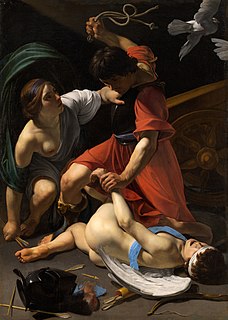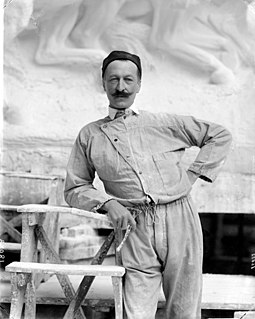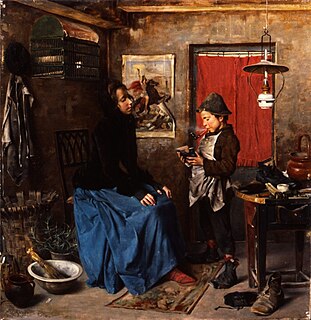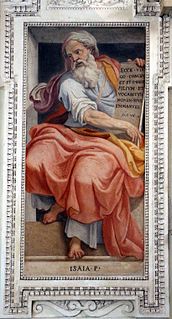This article relies largely or entirely on a single source .(February 2015) |

Giovanni Antonio Molineri (1577 - 1631) was an Italian painter of the late Mannerist and early Baroque period.
This article relies largely or entirely on a single source .(February 2015) |

Giovanni Antonio Molineri (1577 - 1631) was an Italian painter of the late Mannerist and early Baroque period.
He was born in Savigliano and died prematurely there, due to the plague. Molineri came to Rome at the start of the 17th-century, and is documented there till 1615. In Rome, he was in contact with Bartolomeo Manfredi; but no works from this period are known. His work appears influenced by Ludovico Cigoli and Domenico Passignano.
A self-portrait (circa 1620) is present in Savigliano. He also painted frescoes (circa 1620–1621) in the chancel of San Pietro in Savigliano. He worked for the Dukes of Savoy and also for Amedeo Dal Pozzo, Marquess of Voghera. [1]
Gaius Asinius Quadratus was a Greek historian of Rome and Parthia of the third century. He was a senator who wrote a 15-book history of Rome, Chilieteris, which, according to the Suda, covered the period from the founding of Rome until the rule of Alexander Severus. He also wrote a Parthika in nine books, presumably a narrative of the Parthian campaigns of the preceding century. Some scholars attribute to him a Germanika, based on an excerpt preserved by Agathias, although this is debated.

Carlo Saraceni was an Italian early-Baroque painter, whose reputation as a "first-class painter of the second rank" was improved with the publication of a modern monograph in 1968.

The Caravaggisti were stylistic followers of the late 16th-century Italian Baroque painter Caravaggio. His influence on the new Baroque style that eventually emerged from Mannerism was profound. Caravaggio never established a workshop as most other painters did, and thus had no school to spread his techniques. Nor did he ever set out his underlying philosophical approach to art, the psychological realism which can only be deduced from his surviving work. But it can be seen directly or indirectly in the work of Rubens, Jusepe de Ribera, Bernini, and Rembrandt. Famous while he lived, Caravaggio himself was forgotten almost immediately after his death. Many of his paintings were reascribed to his followers, such as The Taking of Christ, which was attributed to the Dutch painter Gerrit van Honthorst until 1990. It was only in the 20th century that his importance to the development of Western art was rediscovered. In the 1920s Roberto Longhi once more placed him in the European tradition: "Ribera, Vermeer, La Tour and Rembrandt could never have existed without him. And the art of Delacroix, Courbet and Manet would have been utterly different". The influential Bernard Berenson stated: "With the exception of Michelangelo, no other Italian painter exercised so great an influence."

Jusepe de Ribera was a Spanish Tenebrist painter and printmaker, also known as José de Ribera and Josep de Ribera. He also was called Lo Spagnoletto by his contemporaries and early writers. Ribera was a leading painter of the Spanish school, although his mature work was all done in Italy.

Domenico Fetti was an Italian Baroque painter who had been active mainly in Rome, Mantua and Venice.

Giovanni Baglione was an Italian Late Mannerist and Early Baroque painter and art historian. He is best remembered for his acrimonious and damaging involvement with the slightly younger artist Caravaggio and his important collection of biographies of the other artists working in Rome in his lifetime, although there are many works of his in Roman churches and galleries and elsewhere.

Cecco del Caravaggio, is the notname given to a painter who worked in Rome in the early decades of the 17th century and was an important early follower of Caravaggio (1571–1610). In the past art historians have suggested he may have been a Flemish, French or Spanish Caravaggist but more recently some have identified the artist with Francesco Boneri, although this is not universally accepted. In his work the artist responded in a very individual and original manner to Caravaggio's naturalism.
Giuseppe Vasi was an Italian engraver and architect, best known for his vedute.

Claude Vignon was a French painter, printmaker and illustrator who worked in a wide range of genres. During a period of study in Italy, he became exposed to many new artistic currents, in particular through the works of Caravaggio and his followers, Guercino, Guido Reni and Annibale Caracci. A prolific artist, his work has remained enigmatic, contradictory and hard to define within a single term or style. His mature works are vibrantly coloured, splendidly lit and often extremely expressive. Vignon worked in a fluent technique, resulting in an almost electric brushwork. He particularly excelled in the rendering of textiles, gold and precious stones.

Nicolas Régnier (1591–1667), known in Italy as Niccolò Renieri, was a painter, art dealer and art collector from the County of Hainaut, a French-speaking part of the Spanish Netherlands. He is often referred to as a Flemish artist because this term was often used to designate people from the Spanish Netherlands. After training in Antwerp, he was active in Italy where he was part of the international Caravaggesque movement. His subjects include genre scenes with card players, fortune tellers, soldiers and concerts, religious scenes, saints, mythological and allegorical scenes, and portraits. He also painted a few scenes with carnivals.

Cesare Arbasia was an Italian painter of the Mannerist period.

Orazio Riminaldi was an Italian painter who painted mainly history subjects in a Caravaggist style.

Simon de Vos was a Flemish painter, draughtsman and art collector. He started his career making small-format cabinet pictures of genre scenes, in particular of Caravaggesque merry companies. Later he switched to history painting, working on larger formats in a Flemish Baroque style which was influenced by Rubens and van Dyck.

Jan Hermansz van Bijlert was a Dutch Golden Age painter from Utrecht, one of the Utrecht Caravaggisti whose style was influenced by Caravaggio. He spent some four years in Italy and was one of the founders of the Bentvueghels circle of northern painters in Rome.

Davide Calandra was an Italian sculptor and cabinet maker.

Jacob Isaacszoon van Swanenburg was a Dutch painter, draftsman and art dealer. He was known for his city views, history paintings, Christian religious scenes and portraits. He spent a substantial part of his early career in Italy before returning to his native Leiden. He was the teacher of the young Rembrandt.

Giacomo Gandi was an Italian painter noted for genre painting.

Giovanni Battista Ricci nicknamed Il Novara after his birth town, was an Italian painter of the late-Mannerist and early-Baroque period, active mainly in Rome.
Niccolò Paganelli was an Italian painter of the late-Renaissance period.

Saint Margaret of Antioch is a 1599 oil on canvas painting by Annibale Carracci, showing Margaret of Antioch. It hangs in Santa Caterina dei Funari church in Rome.